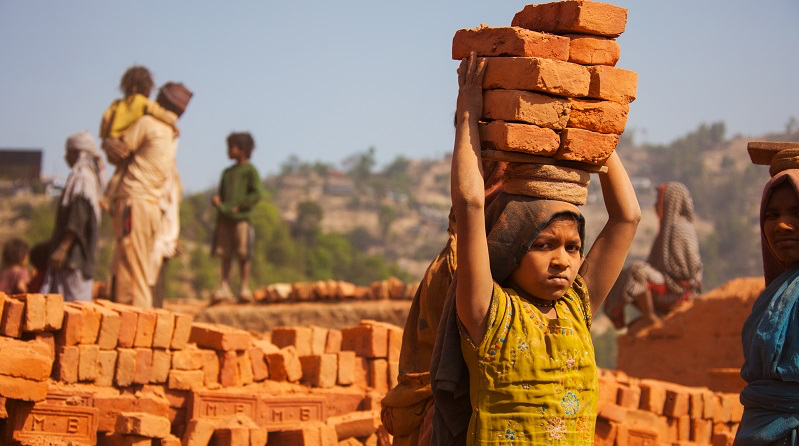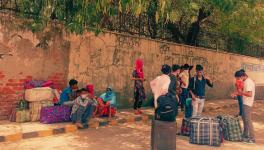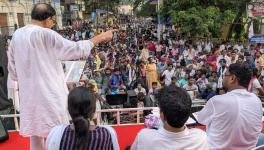Plunging Economy Fuels Apparent Child Labour Epidemic

From the spate of cases that recently have come to light it is evident that child labour is not going to disappear soon. Census 2011 had pegged the number of child workers in India at 10.1 million but activists say that the numbers are much higher now. The reason is India’s alarming rate of unemployment, which is forcing poverty-stricken parents to push young boys and girls into child labour.
Recent police raids triggered by tip-offs from NGOs bear testimony to this trend, which has picked up over the last five years. In the heart of the Capital, seven child workers were burnt to death in the fire that broke out at Anaj Mandi. Another seven are said to have suffered severe burns. The police found nearly 20 minors trapped inside the building. Some had been stitching covers for lunch-boxes and cutting rexin from which bags and jackets are made. They were allegedly earning as little as Rs 2,000 a month for the work.
Most of these child workers were from Bihar, Uttar Pradesh and Jharkhand, but they are not alone. Children from Rajasthan, Odisha, Madhya Pradesh, West Bengal and the North-east are also being trafficked to work in factories. On 30 December 2019, Rajasthan Police and activists of the Asra Vikas Sansthan along with Gujarat Police released 138 child workers from Surat’s textile industry. One was only seven and earned less than Rs 2,000 a month. On 18 December, eight children, four of them girls, were rescued by Delhi police from a placement agency at Shakurpur Basti.
A similar exercise by Chhattisgarh Police last December extricated 70 children from traffickers while they were being ferried to work in a factory in Ahmedabad. Over the last few weeks, 27 children have been released from a jewellery unit in Udaipur, 61 from a jewellery unit in Chennai, 45 from a utensil factory in Delhi’s Wazirpur Industrial Area and another 19 from a factory in NOIDA. All the children complained they were made to work for 12 to 15 hours a day for Rs 1,500-2,000. Many said they were not being paid at all. And there are serious cases coming to light from many other regions.
Kailash Satyarthi, the founder-chairman of Bachpan Bachao Andolan (BBA), paints a horrific picture of the situation. One child disappears every eight minutes in India, he says, and 21 go missing every day in just Delhi. Half are kidnapped for trafficking and never found again. Human trafficking is said to be a $150 billion profit-making industry.
The government has sought to address child labour through the National Child Labour Project or NCLP, which is supposed to identify and rehabilitate child workers. In 2017-18, it was able to rescue around 50,000 child workers. The Centre for Rural Education and Development Action or CREDA, which has been working in the backward district of Mirzapur, has helped rescue and rehabilitate several thousand children over the last three decades. Some of the students went to school and even college and some found work close to their native village.
Atma Ram became a bonded labourer at 12 in the carpet industry of Mirzapur in Uttar Pradesh. He worked as an apprentice and was taught to work a loom. “My malik [employer] paid me Rs 2 per day,” he says. Three years later, CREDA volunteers freed him, sent him to school and today he provides technical support for the right to work programme known as MG-NREGA, and earns Rs 11,000 a month. “Escaping carpet weaving was the best thing that happened to me,” he says.
Raj Narain, from Ahugi Kala village in Mirzapur was a bonded labourer until he was rescued and sent into a special school and then a regular school. After graduation, he received a teacher training certificate and became a Shiksha Mitra, which fetches him a monthly Rs 6,000. “I don’t dwell on those dismal years. My life is transformed,” he says. Narain is married and has four children, whom he is determined to educate well. Bindeshwari was ten when he got a second chance on being rescued from a carpet factory. “Against all odds, I graduated from college and now work as a Gram Rozgar Sewak at a salary of Rs 6000,” he says.
Many rescued girls have also created a new life for themselves. Razia Ansari from Bikna village in eastern Uttar Pradesh lost her father at four and her mother lost her eyesight, too. At eight, she was put into the carpet trade, earning Rs 3 a day. A child labour team took her out of the trade.
Shamshad Khan, founder, CREDA, says, “Razia teaches at the same special school she spent three years at before completing her intermediate in a formal school. She worked there while studying for an MA in sociology. She is a role model for other children, especially girls of her district.”
But such turnaround stories represent only a handful of children. Most never get extricated from establishments that employ child labour. BBA spokesperson Sampurna Behura believes that governments are lackadaisical in tackling child labour and that is how even the Capital city has hubs where trafficked children are trapped in manufacturing units of all kinds. In almost all raids that the BBA has conducted in the National Capital Region, it found that children were working in hazardous conditions—especially, there were no proper fire exits. “These factories operate under the watch of the police, the labour departments and civic authorities, who make no attempt to rein in the practice,” says Behura.
The BBA has identified 187 areas in the NCR where illegal factories are running, but no action has been taken against them.
Just the sheer number of children selling knick-knacks at traffic lights in the Capital displays the utter indifference of the labour department, says Sujata Madhok who has studied child labour in Delhi. “Air pollution is at its worst at traffic lights, where these children work from morning to night. Neither police nor labour inspectors have tried to stop this,” she says.
The existing NCLP does not pay enough attention to convergence between the department of labour, police and other administrative arms headed by the District Commissioner. Most districts have failed to set up child protection units that are meant to oversee the welfare of young children. The Delhi High Court has ordered a task force to be set up in every district, but for this to work, all village child protection officers need to be appointed and sensitised first. Also, lower-ranked, already-overburdened officials, at the district level are given additional charge of controlling child trafficking. They are not even aware how serious the problem is,” Behura says.
The authorities are also unmindful of other solutions to the problem, though they are proposed from time to time. The result is that trafficking continues unabated in almost every corner of India, while their parents struggle with low-paid work and joblessness. Typically, poverty-stricken parents sell children to middle-men for Rs 4,000, sometimes even less. Girls are trafficked for the sex trade for Rs 10,000 to Rs 20,000. According to Khan, more cases of child labour are coming to light now because of growing poverty. Yet the conviction of middlemen is low, as trials linger on for years.
India has 600 million people aged below 25 years and around 480 million younger than 14 years. An exact idea of how safe they are will emerge only after Census 2021.
The author is a freelance journalist. The views are personal.
Get the latest reports & analysis with people's perspective on Protests, movements & deep analytical videos, discussions of the current affairs in your Telegram app. Subscribe to NewsClick's Telegram channel & get Real-Time updates on stories, as they get published on our website.
























